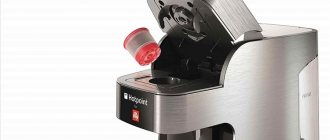What types of manual coffee grinders are there? How to choose a manual coffee grinder? Which coffee grinder is best to buy for a carob coffee maker?
To brew aromatic coffee, it is better to grind the beans immediately before preparation. A manual coffee grinder will help you cope with this task – but how to choose the best one? We'll tell you about the different types and find out what to look for when buying.
The best manual coffee grinders
A manual coffee grinder is a mill that grinds beans using rotating millstones. She makes a small amount of powder, enough for 1-2 cups of aromatic drink. But a good model grinds the grains evenly and allows you to adjust the grinding fineness from coarse to fine.
TimA KC-02
Turkish Brass Coffee Grinder
A manual Turkish coffee grinder is a practical accessory that allows you to achieve the finest grind. The ergonomic model works efficiently and does not take up extra space in the kitchen, but can serve as its decoration.
Reasons to buy:
- Beautiful design;
- compact size;
- possibility of grinding adjustment;
- reliable mechanism and overall durability.
The oriental mill is made of brass and decorated with decorative patterns. The engraving looks expensive and gives the accessory a solid look. The beautiful folding handle is removable and can be stored inside the case.
In the upper part there is a metal bowl and cast iron millstones. At the bottom there is a spherical container with a tray for the finished powder. The distance between the millstones is adjustable. This ensures fine and even grinding.
A small manual chalk in a traditional oriental style is a good alternative to electric models. It is distinguished by functionality and high technical characteristics. This is a real gift for gourmets who are used to starting the day with aromatic Turkish coffee.
Urartu Armenian coffee grinder
For coffee in Turkish
This original beech accessory is a work of art created by hand by famous craftsmen. The mechanism is configured to grind the beans into the finest dust, ideal for brewing Turkish coffee.
Reasons to buy:
- body made of natural beech;
- elegant decor;
- steel working mechanism;
- gentle grinding;
- wear resistance.
The Armenian coffee grinder is carved from natural beech. The outer walls are carefully polished and decorated with national ornaments. Inside there is a metal bowl, steel millstones and a compartment for ground coffee.
The millstones grind the grains into the smallest particles, and the finished powder is smoothly poured through the gaps in the bowl into the lower tier. The model has a tight lid and a handle with a wooden tip. The design is easy to disassemble and clean.
Urartu turns grains into powder for cezve. When brewed, loose powder forms a suspension, due to which oriental coffee seems viscous.
Hario Mini Slim PRO MMSP-1-B
Miniature chalk with three-step adjustment
The Hario mini mill does not break down, is quick to clean and produces fine, medium and coarse powder. The portable accessory fits easily into your bag, making it convenient to take on the road and use while traveling.
Reasons to buy:
- very compact;
- modern appearance;
- simple controls;
- comfortable handle;
- excellent performance.
The cone-shaped coffee grinder is constructed of metal, painted matte black. The lid has an additional belt that ensures a tight closure. There is an ergonomic handle on top that rotates smoothly around its axis.
The upper and lower compartments are securely attached to each other. The first contains a cup designed for 28 grams of beans and ceramic millstones with an additional stopper for grinding. The manual machine does not overheat the grain and preserves its natural taste.
The accessory perfectly performs its functions and produces powder for brewing coffee in a Turk, French press and coffee machine.
TEA-TEA Manual coffee grinder (with container for ground coffee)
Three grind settings
The compact device quickly grinds coffee, suitable for travel and business trips. The wear-resistant and impact-resistant model operates quietly and preserves all the properties of the coffee bean.
Reasons to buy:
- stylish appearance;
- closed body;
- reliable grinding mechanism;
- convenient folding handle;
- sustainability.
The cylindrical container consists of two parts. The upper compartment with a special funnel for grains is made of stainless steel. The lower tier is made of transparent plastic and is used as powder storage. There is a folding handle on the lid.
Conical steel millstones grind grains efficiently, do not absorb foreign odors and do not wear out for a long time. The step control allows you to prepare coarse, medium and fine grind coffee.
The mill is easy to operate and is designed for a small batch of product - only about 50 grams. If you need to brew a drink for several people at once, its volume may not be enough and you will have to grind the grains several times.
Becker BK-2524
Eco-friendly coffee grinder in retro style
A coffee grinder from the German company Bekker is equipped with a retractable coffee drawer for uniform grinding of beans. The design looks elegant and is used as a decorative element in the kitchen, among other things.
Reasons to buy:
- wooden body;
- good grinding quality;
- ceramic millstones;
- compact size;
- quiet sound.
The rectangular wooden body of the mill is decorated with original metal inserts. At the top there is a spacious bowl for grains and a handle that rotates in both directions.
The grinding knives are made of ceramic. They delicately grind whole beans and prevent the penetration of foreign flavors into the coffee. The degree of grinding is adjusted in steps.
Unlike electrical accessories, the Bekker BK-2524 does not overheat the coffee, so it does not lose its aroma. The bean compartment closes. The bowl holds about 40 grams of product. The resulting powder is enough to brew 4-5 cups of the drink.
Mayer & Boch Modern Line
With open metal funnel
Especially for those who appreciate the taste and aroma of freshly ground coffee, Mayer&Boch presented the original Modern Line manual coffee grinder. The convenient model looks beautiful and works flawlessly.
Reasons to buy:
- classic design;
- non-slip base;
- reliable assembly;
- simple grinding adjustment;
- capacity.
A standard mini-mill is a square box with a handle and a pull-out container for ground coffee. The body is made of high-quality ceramics and natural wood.
Modern Line harmoniously combines different materials, fits seamlessly into any interior and becomes a stylish decoration for the kitchen. The outer walls are decorated with images of coffee beans.
At the top there is a metal open funnel for loading fried grains. When the handle rotates, the steel millstones gently grind the coffee. The product comes in a cardboard gift box.
TimA KS 02
Unusual coffee grinder with a brass body. Since the body is made of an alloy of copper and zinc, the grains do not oxidize and remain fresh. The millstones are made of cast iron, which is highly controversial. At the same time, buyers note the ease of grinding.
The lower part of the body is a thicket, also made of brass. It is connected to the upper segment using a thread. Here you need to be careful, since the walls are thin and with a rare turn or jerk it can be torn off.
Of the minuses:
- The manufacturer made a non-standard and uncomfortable handle, which not everyone will like.
- The body is made deliberately roughly, without proper metalworking.
Types of coffee grinders
There are manual coffee grinders of European and Eastern type on sale.
The European grinder looks like a square or rectangular box with a pull-out tray for ready-made coffee and a rotating handle. To operate, the structure is placed on a flat surface.
In the production of European coffee grinders, combined materials are often used, for example, ceramics and wood, plastic and metal. The products look beautiful, performing a practical and decorative function.
Eastern mills have a narrow cylindrical shape. Their body is made of metal or wood and is often decorated with intricate patterns. The handle and funnel are installed on top. The ground coffee flows through tiny holes into the bottom compartment and is immediately removed from there for brewing.
The handles in oriental coffee grinders are often made removable or foldable. They can be folded several times or stored inside the case for storage.
Negative rating - what is better not to take
To ensure that no problems arise during the operation of the device, it is extremely important to find out in advance which coffee grinders-mills you should not choose:
- Devices made of plastic should be avoided. Their service life is shorter than that of those made from other materials (metal, wood);
- You should not buy a unit that does not have a bowl for crushed powder. Extracting the coffee will be problematic and at times dangerous;
- It is recommended to avoid electric coffee grinders that do not have a compartment for the power cable. Storing the device will be problematic. True, this criterion does not belong to the category of defining ones;
- You should also not choose devices that are not equipped with rubber feet . This design detail gives the unit stability and makes its operation almost silent.
Burr grinders are easy to use and produce smooth coffee powder. Many of these units are equipped with a number of additional features. When choosing a particular model, this important point is taken into account. In addition, the material of the body, the millstones, the volume of the grain compartment and a host of other factors are taken into account. Only in this case will you be able to make a successful purchase.
Advantages of manual models
A manual mill allows you to enjoy grinding coffee and feel the exquisite aroma unfolding. Slowly grinding the grains soothes, has a beneficial effect on the nervous system, and the drink itself turns out tasty and healthy, because it is not subject to any negative effects.
The main advantages of mechanical devices:
- grinding adjustment;
- preservation of the taste of grain;
- compact dimensions;
- easy care.
A manual coffee grinder is cheaper than an electric device. It is convenient to take it on business trips and trips. A simple, ergonomic device easily grinds beans even on the go, so you can brew the drink in any convenient place.
How to choose a manual coffee grinder
A manual coffee grinder is in demand among those coffee connoisseurs who enjoy the process of preparing it. To ensure that the accessory meets your expectations, study the basic parameters before purchasing.
Housing material
A variety of raw materials are suitable for the production of housings. Long-term operation is guaranteed by:
- stainless steel;
- brass;
- tin;
- copper.
These materials are resistant to mechanical damage, do not absorb foreign odors and are easy to clean.
Natural wood is a little less durable, and is also gradually imbued with the aroma of coffee. Ceramics and plastic look beautiful and modern, but they crack when dropped, so you can’t count on them to last long.
Millstone
The grinding mechanism of a manual coffee grinder consists of two conical millstones. One of them is fixed in the body, the other is movable. The distance between the cones is changed using a special screw. The more it is twisted, the shorter the distance and finer the grind.
Millstones are made from different materials:
- Ceramics are expensive, high-quality, completely preserve the taste characteristics of the powder, are not afraid of dampness and do not rust.
- Hardened stainless steel is cheaper, but with intensive work the stiffening ribs become thinner and the mill's performance deteriorates. To protect against wear, some manufacturers coat steel cones with a titanium alloy.
- Natural stone is durable, grinds grains into dust and does not change the taste of the product. Unfortunately, it is very expensive and rarely used.
- Cast iron is cheap, but the millstones made from it are gradually ground down. Fine shavings penetrate the powder and the coffee takes on a metallic taste.
Handle location
The handle can be installed on the top or side of the body. To understand which option is more convenient, twist the handle of the selected model, make sure that it rotates easily and does not slip in your palms.
Experts believe that side handles provide better performance. Coffee grinders equipped with them are stable and do not move around the table. In addition, it is easier to twist the vertical handle, since the muscles of the arm, back and shoulder are simultaneously used when working.
Capacity
In mechanical coffee grinders, the bean container is located on the top. It is advisable that the bowl have a lid: a closed container reduces the noise level and prevents powder from spilling out. If the lid is tight, you can store the grains directly in the bowl.
Different mills hold from 10 to 200 grams of product. Choose the volume depending on how much coffee you grind at a time. For one serving, from 7-8 to 13-15 grams of powder is enough. For a large company, a coffee grinder with a 100-200 gram bowl would be an excellent choice.
Do not forget that it is not advisable to grind coffee for future use. In crushed form, it quickly loses its taste.
The powder compartment is located at the bottom. Its capacity is usually 1-2 grams less than the grain bowl.
Millstone material
Millstones are made of hardened and stainless steel, ceramics, stone (an alloy of ceramics and corundum).
What influences the material of the millstones?
The taste of the coffee, the uniformity of the grind and the durability of the millstones. I have already discussed this issue in the review “How to choose a manual coffee grinder” in great detail, so I will not dwell on it now. You can read about the material of the millstones.
One important point. The resource of metal millstones is 250-500 kg of coffee, for ceramics – up to 1,000 kg. After the resource is exhausted, you will need to buy new millstones at the service center. Otherwise, the coffee grinder will stop grinding coffee properly.
What material is best for millstones?
As with manual coffee grinders, I recommend ceramic burrs. The reasons are simple - ceramics are harder than steel, absorb odors less and are not at all afraid of moisture. True, burr coffee grinders with ceramic burrs are a rare thing. Basically, the millstones are still made of stainless steel.
If you can find a coffee grinder with stone burrs, then this will be your best choice. Unfortunately, I have not seen such coffee grinders. But maybe I was just looking poorly?
FAQ
How to change the grind fineness in a manual coffee grinder? There are two options for changing the grinding degree: stepwise and stepless. The first is typical for European mills and involves step-by-step adjustment. To change the grind, unscrew the top nut on the handle, remove the washer and place the adjusting nut in the special recess. There are usually three of them: for fine, medium and coarse grinding. Then put back the washer, handle and top nut.
Stepless adjustment is found in oriental coffee grinders. It provides a smooth reduction and fine grind, suitable for brewing Turkish coffee.
Are there any disadvantages to manual coffee grinders? The only drawback of mechanical models is that grinding takes time - the productivity of such mills is low. It takes a few minutes to prepare a one-cup portion of the powder. Because of this, it is difficult to recommend it to busy people who live in a fast pace and do not want to waste time grinding beans by hand.
How to care for a manual coffee grinder? After each use, clean the bowl and powder container from product residues with a dry cloth. Treat hard-to-reach areas with a brush or cotton swab. If this is not done, the walls and parts of the chalk will become covered with oil deposits and coffee dust. Old particles mix with fresh coffee and give it a bitter taste.
When cleaning the coffee grinder, do not use abrasives or regular dish soap. Assemble the structure after complete drying. To prevent the appearance of foreign odors, use the machine only for coffee.











